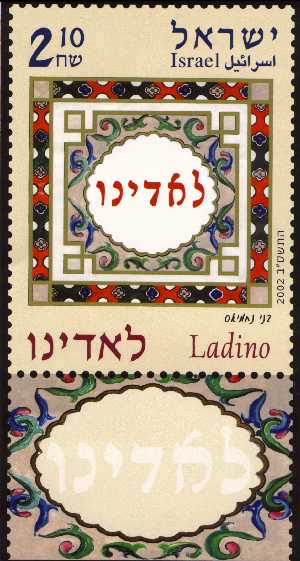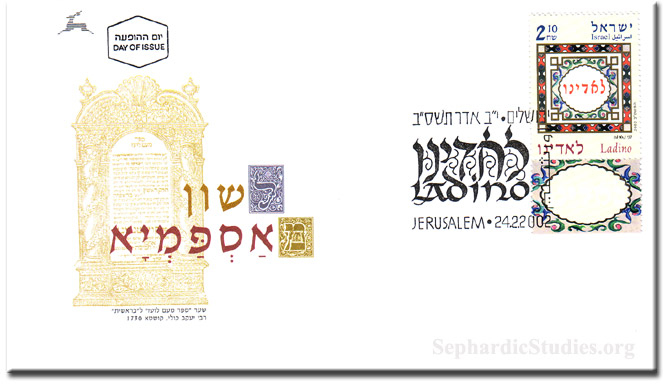Language of the Sephardim Honored on a Postage Stamp
On the first day cover is a photograph of the front cover of the 'Meam Loez', Genesis volume Rabbi Yakoub Hulli, Constantinople, 1730. The photograph is by courtesy of Jewish National and University Library, Jerusalem. The words 'Language of Spain' appear on the first day cover. The illustration on the stamp is based on decorations inspired by ancient Spanish writings. The word 'Ladino', written in Rashi script, is in the center of the illustration.
Apart from the rich folklore that surrounds Ladino (ballads, love songs, poetic festivities, stories and sayings) works of 13 major importance were written in this language. "Meam Loez", a multi volume essay on the Bible, is a major religious work written in Ladino. The leading scholar, Rabbi Yakoub Hulli, originated this work and wrote the first two volumes. "Meam Loez" is a kind of comprehensive encyclopedia on biblical interpretations, midrash, ethics, halacha and customs printed next to reports on experiences of the world, nature and the universe, The contents are taken from hundreds of sources in Hebrew literature. The first volume on Genesis appeared in Constantinople in 1730.
The era of Enlightenment began in the Ottoman Empire during the middle of the 19th Century. One of the expressions of Enlightenment was the appearance of journals in Ladino. The first journal "Puertas del Oriente" was published in Izmir in 1845/6. This was the beginning of 150 years of Ladino journalism during which more than 300 periodicals were published. The journals brought with them translated and original novels. Hundreds of them were printed in the printing centers of Ladino (among them- Constantiople. Izmir. Salonica, Jerusalem and Vienna) and gave pleasure to thousands of readers. Theater also flourished at this time. It is known that since the last quarter of the 18th century, more than 200 Ladino plays we-restaged for the Sephardic (Jews of Spanish descent) communities.
The Ladino-speaking Sephardi Jews suffered the terrible Holocaust like their Yiddish speaking Ashkenazi (Jews of Central or Eastern European descent) brothers, The ancient communities such as Salonica and other Greek communities, Macedonia, Serbia and Bosnia, were wiped out. The majority of the Sephardi Jewish community in Europe was annihilated. It was thought that after the devastating Holocaust, Ladino would not be revived. However, recent years have seen an awakening towards all that is connected to language and heritage. There are poetry books and folklore and research is being carried out.
The language is studied in universities and other institutions. The highlight is the National Authority for Ladino Culture Bill, for the development and preservation of the language, passed in 1996 by the Israeli Parliament (Knesset) and the establishment of the National Authority for Ladino Culture headed by Yitzhak Navon, Israel's fifth President.
Avner
Perez Ben Gurion
University of the Negev, Beer Sheva

|
The artist is "Ben Tsion (Benny) Nahmias" Nahmias was born in Israel in 1931. He fulfilled various top positions in industry. He studied sculpture with the artist Roddy Lehman and graphics with Edwinah Lehman. For a long period he worked on the visual arts. Today he focuses his work on Jewish art, illustrations and book design, essays on Jewish literature and design. Nahmias's work includes: hand- writting on parchment; illustration of the Passover Hagadda in a Jerusalem style; editing and illustrating " Songs of Spain" - an anthology of Hebrew poems during the Golden Age. Both works were inspired by ancient writings. Nahmias also is involved in various public activities. To purchase the stamp: ISRAEL PHILATELIC SERVICE 12 Sderot Yerushalayim 68021 Tel Aviv-Yafo Tel: 972-3-5123933 Fax: 972-3-6836794 The stamp was issued February 24, 2002/5762 |



